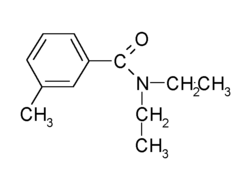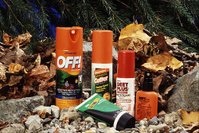Diethyltoluamide
DEET (CAS# 134-62-3) is an insect-repellent chemical (Chemical name: N,N-diethyl-meta-toluamide or N,N-diethyl-3-methylbenzamide or Benzamide, N,N-diethyl-3-methyl-). It is intended to be applied to the skin or to clothing, and is primarily used to protect against insect bites. In particular, DEET protects against tick bites (which transmit Lyme disease) and mosquito bites (which transmit dengue fever, West Nile fever and malaria). more...
DEET was developed by the United States Army, following its experience of jungle warfare during World War II. It entered military use in 1946 and civilian use in 1957.
DEET is the most common active ingredient in insect repellents. Studies into the health effects of DEET have not shown any significant harm to human health (other than for those who are allergic to DEET), but concerns arising from its chemical composition mean that care should be taken in its application. Current mainstream medical opinion is that any dangers posed by DEET are greatly outweighed by those of the serious insect-borne diseases which DEET helps prevent. However, some newer repellents offer alternatives. Repellents containing picaridin or lemon eucalyptus oil were reported by Consumer Reports to be about as effective as repellents containing DEET, though medical studies have differed on the effectiveness of alternatives. A number of tests have shown DEET to be the most effective and longest-lasting insect repellent available.
Because of its relative harmlessness, DEET is often sold and used in concentrations up to 100%. Although this offers the strongest short-term protection against insect bites, it is often not as effective in the long term as formulas containing less DEET (30%-60%). The reason for this is that pure DEET will not long adhere to human skin, and will evaporate, rub, or wash off in time. Formulas with lower concentrations often contain lotions or other agents which allow the formula to adhere to skin longer and provide longer-lasting protection. Any lessening of the strength of the protection as a result of the lower concentration may be countered by applying a greater quantity of the substance. Likewise, pure DEET may be reapplied as necessary to sustain the desired level of repellence.
DEET is believed to work by blocking insect receptors (notably those which detect carbon dioxide and lactic acid) which are used to locate hosts. DEET effectively "blinds" the insect's senses so the biting/feeding instinct is not triggered by humans or animals which produce these chemicals.
DEET can damage some plastics, rayon, spandex, other synthetic fabrics, leather, and painted or varnished surfaces; it does not damage natural fibers, such as cotton or wool, and has no effect on nylon.
Read more at Wikipedia.org



